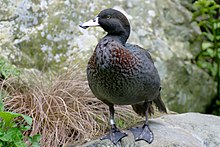Blue Duck
| Blue Duck | |
|---|---|
 | |
| Blue Duck at Staglands, Akatarawa Valley | |
| Conservation status | |
| Scientific classification | |
| Kingdom: | Animalia |
| Phylum: | Chordata |
| Class: | Aves |
| Order: | Anseriformes |
| Family: | Anatidae |
| Subfamily: | Tadorninae |
| Genus: | Hymenolaimus G.R. Gray, 1843 |
| Species: | H. malacorhynchos |
| Binomial name | |
| Hymenolaimus malacorhynchos (Gmelin, 1789) | |
| Subspecies | |
| |
The Blue Duck (Hymenolaimus malacorhynchos) is a member of the duck, goose and swan family Anatidae endemic to New Zealand. It is the only member of the genus Hymenolaimus, placed in the shelduck subfamily Tadorninae after previously being considered part of the paraphyletic "perching duck" assemblage. The Māori name, sometimes used in English, is whio, which is an onomatopoetic rendition of the males' call.
The Blue Duck features on the reverse side of the New Zealand $10 note.
Description
The Blue Duck is a dark slate-grey with a chestnut-flecked breast and a paler bill and eye. The pinkish-white bill has fleshy flaps of skin hanging from the sides of its tip. The male's call is an aspirated whistle, and the female's is a rattling growl. The Blue Duck is born with a green beak for just 8 hours after birth; where it then develops to its final colour.
Ecology and behaviour
This species is an endemic resident breeder in New Zealand, nesting in hollow logs, small caves and other sheltered spots. It is a rare duck, holding territories on fast flowing mountain rivers. It is a powerful swimmer even in strong currents, but is reluctant to fly. It is difficult to find, but not particularly wary when located.
Status
The Blue Duck is a very localised species now threatened by predation from introduced mammals especially stoats, competition for its invertebrate food with introduced trout, and damming of mountain rivers for hydroelectric schemes. It is listed as Nationally Endangered in the New Zealand Threat Classification System. In 2009 the New Zealand Department of Conservation started a ten-year recovery programme to protect the species at eight sites using predator control and then re-establish populations throughout their entire former range.


No comments:
Post a Comment